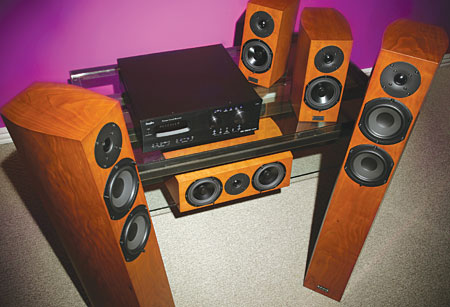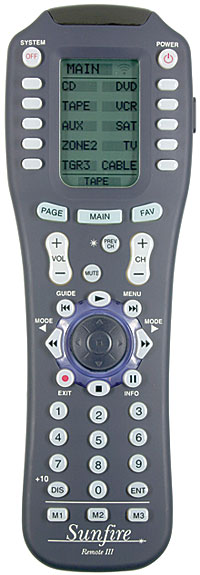Audio Physic Spark Speaker System and Sunfire Theater Grand TGR-3 A/V Receiver
Even a quick glance at the home theater section of your local consumer electronics retailer reveals an overabundance of A/V receivers. They're a staple component in home theater. After you sift through all the ubiquitous brands, you'll come across Sunfire. The company is the creation of the venerable Bob Carver, also founder of Phase Linear and Carver Corporation. In a previous audio life, I sold many Phase Linear 400 and 700 power amplifiers, which were among the most popular and affordable high-powered stereo amps during the 1970s. Bob Carver has consistently reinvented himself and refined his product offerings, and one of his latest creations is the Sunfire Theater Grand TGR-3 A/V receiver from the company's XT Series. It's a component that borrows many features from Sunfire's high-end processors and amplifiers. And its straightforward operation, proprietary features, and impressive sound quality might earn it a place among the best high-end receivers. The TGR-3 is a great example of meticulous American design, albeit of Chinese construction.

Only speakers outnumber the selection of receivers on the market. You know the common brands, but you may not have heard the name Audio Physic. While well known and highly acclaimed among high-end circles in Europe, the German manufacturer is establishing their presence in the United States. Audio Physic's motto and design standard is uncomplicated: "No loss of fine detail." That claim appears beneath the logo on the front of their speakers. If fine detail means the speaker's fit and finish, I'd have to agree, but I suspect that they're referring to audio detail. I knew that, if my experience with German-engineered loudspeakers was to be similar to my appreciation for German automobiles, I was in for a treat.
This month's spotlight shines on this system. I ran the Sunfire Theater Grand TGR-3 receiver and an Audio Physic five-channel speaker system through their paces to find out if they're genuinely deserving of the limelight.
First Impressions Are Lasting Ones
Long before the 20-to-50-hour recommended break-in period was complete, I was sitting in the Audio Physic Spark towers' sweet spot, despite my plans to finish a long-overdue home-improvement project. Far from being a convenient excuse to avoid work, the Sparks gave me ample reason to listen. Everything I played, from Carlos Franzetti to Chet Atkins, sounded three-dimensional, with a clear, focused image and broad soundstage, even though I gave little initial thought to the speakers' placement in the room. Vocals seemed to float in one layer, instruments in another—all integrated in a coherent two-channel soundfield. Laverne Butler's "Isn't It a Pity" (The World's Greatest Audiophile Vocal Recordings, Chesky Records) best demonstrated the depth and layering of the sonic image, along with excellent vocal clarity and resolution. "What's a Little More Rain" by Sara K., from the same Chesky SACD, revealed a similar attention-getting vocal presence. It served to remind me of the many reasons to appreciate good stereo reproduction in a surround sound world.
Although I hadn't activated the feature, it sounded as if Sonic Holography might have been at work here. Sonic Holography is a Sunfire signature technology that Bob Carver developed. It is a DSP function designed to improve dimension in stereo recordings, broadening and deepening the soundstage. While it is very effective at enhancing stereo imaging, Sonic Holography was not operating in this case, and it sounded as if the Sunfire TGR-3 and the Sparks possessed these characteristics naturally.
Attack Is Everything
Transient sounds are short-lived by definition. In reproduced music, their snappy attack provides a keen sense of realism and sonic accuracy. The faithful reproduction of a piano or other percussion instrument partially depends upon clean transient response and precise control of each driver in a speaker system. These are tasked to both amp and speaker, and there was every indication that excellent compatibility existed between the TGR-3 and the Audio Physic speakers. Roy Orbison's "Only the Lonely" from his Black & White Night live DVD had just the right amount of midbass punch. It was articulate and taut, with no overhang or boominess—as nimble and agile as a Beemer or Benz in a quick lane change—with no swerving. The mandolins in Nickel Creek's self-titled SACD (Sugar Hill Records) sounded crisp, clean, and distinct from other instruments. Virtually every percussion instrument sounded sharp, with a concise yet graceful attack—not edgy or harsh.
It's likely that the Sunfire TGR-3's Tracking Downconverter power-supply design takes equal credit with the speakers for the system's transient response. As an added benefit, it also reduces the weight of the receiver. Because of the efficient power supply, it runs exceptionally cool, even though it has no external heatsinks. When was the last time you touched a 1,400-watt, seven-channel receiver that felt lukewarm and weighed only 32 pounds?
Looks Can Be Deceiving
The Spark front speakers have an understated appearance. At a mere 37 pounds each, they're somewhat deceiving. Although they're considered tower speakers, at 38.6 inches high, they hardly dominate the room. Fit quality at the joints is excellent, especially when you consider the difficult task of crafting joints for a speaker enclosure with a size and shape I would describe as a medium-height, partially elliptical, 7-degree parallelogram. The front baffle's 7-degree angle aids in time alignment of the drivers, which is an important concept, but it also makes the towers appear to want to fall backward. The four feet, equipped with speaker spikes, prevent that from happening. The complement of drivers includes a 6-inch bass driver, a 6-inch bass/midrange driver, and a 1-inch soft dome tweeter in a rear-ported enclosure, comprising a two-and-a-half-way design. My review samples came in a deep, honey-colored cherry veneer, one of the five available finishes. It seems that the sound quality combined with the understated appearance might satisfy both audiophile and interior decorator. The speakers include useful setup instructions for optimal placement in the room.
 The balance of the Audio Physic five-channel speaker system I tested consisted of the Celsius center channel and two Step surround speakers. (I occasionally used my own subwoofer, but it typically wasn't necessary.) The Celsius is a two-way, shelf-mounted center-channel speaker with a driver complement similar to the Spark's. According to Audio Physic, the Celsius can also double as a surround speaker when laid on its end. But don't overlook the Step surround speaker, equipped with a single 6-inch driver and a 1-inch soft dome tweeter. Although I prefer surround and center-channel speakers that are identical to the front left and right speakers, the Celsius and Step speakers had similar tonal qualities as the Sparks, and together they created a full, enveloping soundfield. The receiver and speakers showed off their best in Tchaikovsky's andante from Symphony No. 6 on the multidisc classical DVD collection from DTS Entertainment. The system brought out the orchestra's full timbre in this excellent multichannel recording.
The balance of the Audio Physic five-channel speaker system I tested consisted of the Celsius center channel and two Step surround speakers. (I occasionally used my own subwoofer, but it typically wasn't necessary.) The Celsius is a two-way, shelf-mounted center-channel speaker with a driver complement similar to the Spark's. According to Audio Physic, the Celsius can also double as a surround speaker when laid on its end. But don't overlook the Step surround speaker, equipped with a single 6-inch driver and a 1-inch soft dome tweeter. Although I prefer surround and center-channel speakers that are identical to the front left and right speakers, the Celsius and Step speakers had similar tonal qualities as the Sparks, and together they created a full, enveloping soundfield. The receiver and speakers showed off their best in Tchaikovsky's andante from Symphony No. 6 on the multidisc classical DVD collection from DTS Entertainment. The system brought out the orchestra's full timbre in this excellent multichannel recording.
The Brains Behind the Elegance
The Sunfire TGR-3 receiver is a handsome component with a refined appearance. Its two large knobs (volume and source selection) dominate the front panel and are accompanied by tuner and tone controls and an array of system-status indicator lights, as well as a standby/off button.
No review of an A/V receiver is complete without a discussion of usability. Sophisticated A/V receivers employ lots of computer technology, which can sometimes complicate the user interface. With a typical receiver's multitude of controls and adjustments, flexibility has naturally spawned complexity. A few manufacturers (and Sunfire is one of them) have overcome the usual tangle of menus and submenus to create a system that's both easy to navigate and to use. The Sunfire TGR-3's main menu is organized into five submenus, each with logical, intuitive descriptions that make it easy to quickly find the control you want. Personally, I would rather listen to music than read an owner's manual, and I didn't have to consult the manual before I used the TGR-3.
A key usability issue is the remote volume control, about which I would caution users. When you press and hold this button, the volume level increases at a moderate pace, then accelerates rapidly, resulting in unexpectedly high sound levels and potential speaker damage.
Rather than present a spec-sheet list of features, suffice it to say that the TGR-3 seven-channel, multiroom, Flash-upgradeable, Ethernet-equipped A/V receiver with two HDMI inputs and a 150-MIPS Motorola Symphony processor will provide all of the connectivity, processing clout, and horsepower to satisfy even a demanding high-end user. It's also a great-sounding receiver.
Last Thoughts
Neither Sunfire nor Audio Physic would poll high in a top-of-mind brand-awareness questionnaire, but both deserve consideration as top performers in their classes. The Sunfire TGR-3 sounds good, it's built well, and it's easy to use. The Audio Physic speakers sound full, transparent, and detailed, and they have great imaging. Every audiophile has a list of favorites, and I will add these to my list of enjoyable, musical components.
Highlights
Audio Physic Spark Speaker System:
• Five-channel system produces a cohesive soundfield
• Substantial sound even without a subwoofer
• Available in five beautiful finishes
Highlights
Sunfire Theater Grand TGR-3 A/V Receiver
• The TGR-3 sounds good, it's built well, and it's easy to use
• Unique power supply stays cool
- Log in or register to post comments




































































